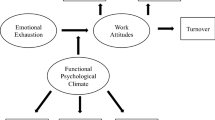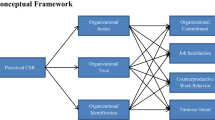Staff turnover in mental health service organizations is an ongoing problem with implications for staff morale, productivity, organizational effectiveness, and implementation of innovation. Recent studies in public sector services have examined the impact of organizational culture and climate on work attitudes (i.e., job satisfaction and organizational commitment) and, ultimately, staff turnover. However, mediational models of the impact of culture and climate on work attitudes have not been examined. The present study examined full and partial mediation models of the effects of culture and climate on work attitudes and the subsequent impact of work attitudes on staff turnover. Multilevel structural equation models supported a partial mediation model in which organizational culture had both direct influence on work attitudes and indirect influence through organizational climate. Work attitudes significantly predicted one-year staff turnover rates. These findings support the contention that both culture and climate impact work attitudes and subsequent staff turnover.




Similar content being viewed by others
References
Aarons G. A. (2004). Mental health provider attitudes toward adoption of evidence-based practice: The Evidence-Based Practice Attitude Scale. Mental Health Services Research 6(2):61–72
Aarons, G. A. (2005). Measuring provider attitudes toward adoption of evidence-based practice: Consideration of organizational context and individual differences. Child and Adolescent Psychiatric Clinics of North America. 14(2): 255-271.
Aarons, G. A., & Sawitzky, A. C. (2006). Organizational culture and climate and mental health provider attitudes toward evidence-based practice. Psychological Services, 3(1), 61–72.
Aarons, G. A., Woodbridge, M., & Carmazzi, A. (2003). Examining leadership, organizational climate and service quality in a children’s system of care. In C. Newman, C. Liberton, K. Kutash, & R. Friedman (Eds.), The 15th Annual Research Conference Proceedings, A System of Care for Children’s Mental Health: Expanding the Research Base (pp. 15–18). Tampa: University of South Florida, Louis de la Parte Florida Mental Health Institute
Albizu-Garcă-a C. E., Ră-Os R., Juarbe D., Alegră-a M. (2004). Provider turnover in public sector managed mental health care. Journal of Behavioral Health Services & Research 31(3):255–265
Argote L., Insko C. A., Yovetich N., Romero A. A. (1995). Group learning curves: The effects of turnover and task complexity on group performance. Journal of Applied Social Psychology 25(6):512–529
Ashkanasy N. M., Wilderom C. P. M., Peterson M. F. (2000). Handbook of organizational culture and climate. Thousand Oaks, CA, Sage
Barriere M. T., Anson B. R., Ording R. S., Rogers E. (2002). Culture transformation in a health care organization: A process for building adaptive capabilities through leadership development. Consulting Psychology Journal: Practice & Research 54(2):116–130
Bingley P., Westergaard-Nielsen N. (2004). Personnel policy and profit. Journal of Business Research 57(5):557–563
Buckingham M., Coffman C. (1999). How great managers develop top people. Workforce 78(6):102–104
Burke W. W. (1994). Diagnostic models for organization development. In Howard A. (eds), Diagnosis for organizational change: Methods and models. New York, Guilford Press, pp. 53–84
Carmazzi, A., & Aarons, G. A. (2003). Organizational culture and attitudes toward adoption of evidence-based practice. Paper presented at the NASMHPD Research Institute’s 2003 Conference on State Mental Health Agency Services Research, Program Evaluation, and Policy, Baltimore, MD
Clay R. (2004 November/December). The workforce crisis: SAMHSA’s response. SAMHSA News 12(6):5–7
Cohen J. (1988). Statistical power analysis for the behavioral sciences (2nd ed). Hillsdale, NJ, Lawrence Erlbaum Associates
Cooke R. A., Szumal J. L. (2000). Using the Organizational Culture Inventory to understand the operating cultures of organizations. In Ashkanasy N. M., Wilderom C. P. M., Peterson M. F. (eds), Handbook of organizational culture and climate. Thousand Oaks, CA, Sage, pp. 147–162
Cooke R. A., Rousseau D. M. (1988). Behavioral norms and expectations: A quantitative approach to the assessment of organizational culture. Group & Organization Studies 13(3):245–273
Drake B., Yadama G. N. (1996). A structural equation model of burnout and job exit among Child Protective Services workers. Social Work Research 20(3):179–187
Farmer E. M., Compton S. N., Burns B. J., Robertson E. (2002). Review of the evidence base for treatment of childhood psychopathology: Externalizing disorders. Journal of Consulting and Clinical Psychology 70(6):1267–1302
Gallon S. L., Gabriel R. M., Knudsen J. R. W. (2003). The toughest job you’ll ever love: A Pacific Northwest treatment workforce survey. Journal of Substance Abuse Treatment 24(3):183–196
George G., Sleeth R. G., Siders M. A. (1999). Organizing culture: Leader roles, behaviors, and reinforcement mechanisms. Journal of Business & Psychology 13(4):545–560
Gill S., Greenberg M. T., Vazquez A. (2002). Changes in the service delivery model and home visitors’ job satisfaction and turnover in an Early Head Start program. Infant Mental Health Journal. Special Issue: Early Head Start 23(1–2):182–196
Glisson C. (2002). The organizational context of children’s mental health services. Clinical Child and Family Psychology Review 5(4):233–253
Glisson, C., Dukes, D., & Green, P. (in press). The effects of the ARC organizational intervention on caseworker turnover, climate, and culture in children’s service systems. Child Abuse & Neglect
Glisson C., Durick M. (1988). Predictors of job satisfaction and organizational commitment in human service organizations. Administrative Science Quarterly 33(1):61–81
Glisson C., Hemmelgarn A. (1998). The effects of organizational climate and interorganizational coordination on the quality and outcomes of children’s service systems. Child Abuse and Neglect 22(5):401–421
Glisson C., James L. R. (2002). The cross-level effects of culture and climate in human service teams. Journal of Organizational Behavior 23:767–794
Glisson C. A., Martin P. Y. (1980). Productivity and efficiency in human service organizations as related to structure, size, and age. Academy of Management Journal 23(1):21–37
Gray A., Phillips V., Normand C. (1996). The costs of turnover: Evidence from the British National Health Service. Health Policy 38:117–128
Hackman J. R., Oldham G. R. (1980). Work redesign. Reading, MA, Addison-Wesley
Hedeker D. R., Gibbons R. D., Davis J. M. (1991). Random regression models for multicenter clinical trials data. Psychopharmacology Bulletin 27(1):73–77
Hom P. G. R. (1995). Employee turnover. Cincinnati, OH, South-Western
Howard B., Gould K. E. (2000). Strategic planning for employee happiness: A business goal for human service organizations. American Journal on Mental Retardation 105(5):377–386
Hu L., Bentler P. M. (1999). Cutoff criteria for fit indexes in covariance structure analysis: Conventional criteria versus new alternatives. Structural Equation Modeling 6(1):1–55
James L. R. (1982). Aggregation bias in estimates of perceptual agreement. Journal of Applied Psychology 67(2):219–229
James L. R., Demaree R. G., Wolf G. (1993). r wg : An assessment of within-group interrater agreement. Journal of Applied Psychology 78(2):306–309
James L. R., Hater J. J., Gent M. J., Bruni J. R. (1978). Psychological climate: Implications from cognitive social learning theory and interactional psychology. Personnel Psychology 31:783–813
James L. R., Sells S. B. (1981). Psychological climate: Theoretical perspectives and empirical research. In: Magnusson D. (eds), Toward a psychology of situations: An interactional perspective. Hillsdale, NJ, Lawrence Erlbaum Associates, pp. 275–450
Jayaratne S., Chess W. A. (1984). Job satisfaction, burnout, and turnover: A national study. Social Work 29(5):448–453
Kenward M. G., Molenberghs G. (1998). Likelihood based frequentist inference when data are missing at random. Statistical Science 13:236–247
Klein K. J., Bliese P. D., Kozolowski S. W. J., Dansereau F., Gavin M. B., Griffin M. A. et al. (2000). Multilevel analytical techniques: Commonalities, differences, and continuing questions. In: Klein K. J., Kozlowski S. W. J. (eds), Multilevel theory, research, and methods in organizations: Foundations, extensions, and new directions. San Francisco, Jossey-Bass, pp. 512–553
Knudsen H. K., Johnson J. A., Roman P. M. (2003). Retaining counseling staff at substance abuse treatment centers: Effects of management practices. Journal of Substance Abuse Treatment 24(2):129–135
Lawler E. E., Hall D. T., Oldman G. R. (1974). Organizational climate: Relationship to organizational structure, process, and performance. Organizational Behavior and Human Performance 11(1):139–155
Lease S. H. (1998). Annual review, 1993–1997: Work attitudes and outcomes. Journal of Vocational Behavior 53(2):154–183
Little R. J., Rubin D. B. (2002). Statistical analysis with missing data (2nd ed.). New York, John Wiley & Sons
Locke E. A. (1990). The nature and causes of job satisfaction. In: Dunnette M. D. (eds), Handbook of industrial and organizational psychology. Chicago, Rand McNalley College, pp. 1297–1349
Martin T. N. (1981). A path analytic investigation of Price’s turnover model. Managerial Psychology 2(1):1–14
Maslach C., Schaufeli W. B., Leiter M. P. (2001). Job burnout. Annual Revue of Psychology 52:397–422
Michaels C. E., Spector P. E. (1982). Causes of employee turnover: A test of the Mobley, Griffeth, Hand, and Meglino model. Journal of Applied Psychology 67(1):53–59
Mobley W. (1982). Some unanswered questions in turnover and withdrawal research. Academy of Management Review 7(1):111–116
Morris A., Bloom J. R. (2002). Contextual factors affecting job satisfaction and organizational commitment in community mental health centers undergoing system changes in the financing of care. Mental Health Services Research 4(2):71–83
Mowday R. T., Porter L. W., Steers R. M. (1982). Employee-organization linkages: The psychology of commitment, absenteeism and turnover. New York, Academic Press
Mueller R. O. (1996). Basic principles of structural equation modeling. New York, Springer
Muthén L. K., Muthén B. O. (1998–2004). Mplus user’s guide (3rd ed.). Los Angeles, Muthén & Muthén
Neuman K. (2003). The effect of organizational reengineering on job satisfaction for staff in hospital social work departments. Social Work in Health Care 36(4):19–33
Ostroff C., Schmitt N. (1993). Configurations of organizational effectiveness and efficiency. Academy of Management Journal 36(6):1345–1361
Priestland A., Hanig R. (2005). Developing first-level leaders. Harvard Business Review 83:112–120
Pritchard R. D., Karasick B. W. (1973). The effects of organizational climate on managerial job performance and job satisfaction. Organizational Behavior & Human Decision Processes 9(1):126–146
Raudenbush S. W., Bryk A. S. (2002). Hierarchical linear models: Applications and data analysis methods (2nd ed.). Thousand Oaks, CA, Sage
Rousseau D. M. (1990). Normative beliefs in fund-raising organizations: Linking culture to organizational performance and individual responses. Group & Organization Studies 15:448–460
Satorra A., Bentler P. M. (2001). A scaled difference chi-square test statistic for moment structure analysis. Psychometrika 66(4):507–514
Schoenwald S. K., Sheidow A. J., Letourneau E. J., Liao J. G. (2003). Transportability of multisystemic therapy: Evidence for multilevel influences. Mental Health Services Research 5(4):223–239
Snijders T., Bosker R. (1999). Multilevel analysis: An introduction to basic and advanced multilevel modeling. London, Sage
Tai T., Bame S. I., Robinson C. (1998). Review of nursing turnover research, 1977–1996. Social Science & Medicine 47(12):1905–1924
Van Breukelen W., Van Der Vlist R., Steensma H. (2004). Voluntary employee turnover: Combining variables from the ‘traditional’ turnover literature with the theory of planned behavior. Journal of Organizational Behavior 25(7):893–914
Verbeke W., Volgering M., Hessels M. (1998). Exploring the conceptual expansion within the field of organizational behaviour: Organizational climate and organizational culture. Journal of Management Studies 35(3):303–330
Verquer M. L., Beehr T. A., Wagner S. H. (2003). A meta-analysis of relations between person-organization fit and work attitudes. Journal of Vocational Behavior 63(3):473–489
Author information
Authors and Affiliations
Corresponding author
Rights and permissions
About this article
Cite this article
Aarons, G., Sawitzky, A. Organizational Climate Partially Mediates the Effect of Culture on Work Attitudes and Staff Turnover in Mental Health Services. Adm Policy Ment Health 33, 289–301 (2006). https://doi.org/10.1007/s10488-006-0039-1
Published:
Issue Date:
DOI: https://doi.org/10.1007/s10488-006-0039-1




